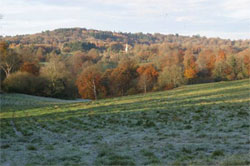Woodlands and trees in the Landscape
 The AONB is characterised by large swathes of ancient woodland, while designed woodland elements also dominate.
The AONB is characterised by large swathes of ancient woodland, while designed woodland elements also dominate.
Ancient broad leaved woodland which coincide with key areas of the Medieval hunting chase and Medieval forests. The ancient woodlands are associated with archaeological earthworks including ancient field systems. These woodlands have been transformed in the last 150 years from an underwood dominated industry to high forest. However the Cranborne Chase Woodlands centred on Tollard Royal form the centre of an important area of coppice woodland.
The ancient woodland on Great Ridge forms the only large area of ancient semi-natural woodland not associated with a Medieval hunting area.
Copses and mature hedgerows around fields mark the location of woodland clearance especially notable in the Vale of Wardour and ancient and veteran trees associated with Medieval Deer Parks, Parkland and ancient boundaries.
Some Woodlands form structural planned elements in the landscape characterised by great avenues of trees, for example at Kingston Lacy and in the Chalke Valley. Large scale planting of Trees and woodland belts are associated with the creation of 18th and 19th century landscape parks. This is best demonstrated by the construction of the great Brownian Ride at Wimborne St Giles and by Longleat. The impact of the great estates on the landscape is also marked by large scale plantations of conifers especially in the 19th century and post 1918, for example to the east of Longleat.
There has been an increased woodland cover in the downland areas in the 20th century, characterised by the creation of linear and angular plantations and belts of trees for fox and game coverts.
More information on the historic woodlands of the AONB can be accessed by clicking here: Theme 13: Woodlands and Trees in the Landscape.
This document forms part of the wider AONB Historic Environment Action Plans.
